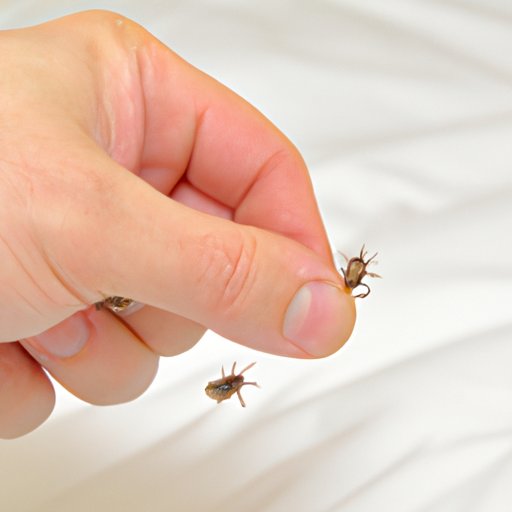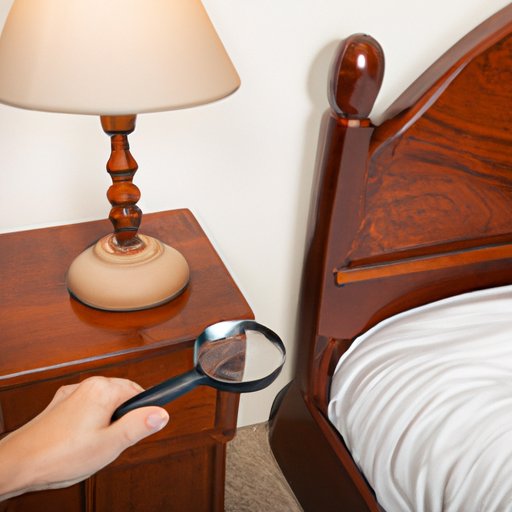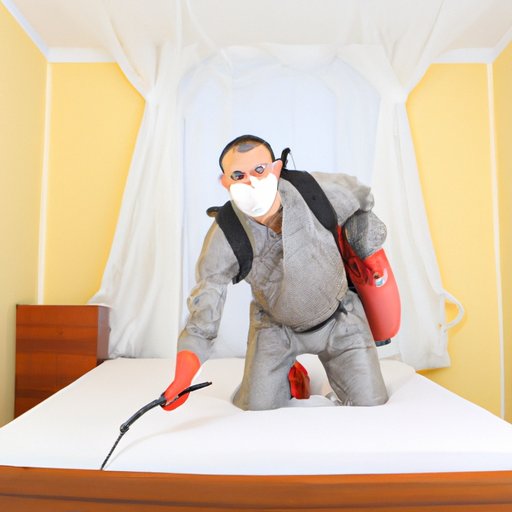Introduction
Bed bugs are small insects that feed on the blood of humans and animals. They’re reddish-brown in color and can grow up to 4 to 5 millimeters in length. Bed bugs are nocturnal creatures and they typically hide during the day in dark crevices and cracks, such as mattresses, furniture, carpets, and baseboards.
Identifying and addressing a bed bug infestation quickly is important for several reasons. According to the Centers for Disease Control and Prevention (CDC), “bed bugs are not known to spread disease, but their bites may cause allergic reactions in some people.” In addition, bed bugs can reproduce rapidly and can spread quickly throughout a home or building.

Identifying Bed Bugs from Bites
One way to tell if you have bed bugs is by looking for signs of their bites. Bed bug bites may appear as small, red bumps on the skin that can be itchy and irritating. According to the American Academy of Dermatology, “bed bug bites usually appear in clusters on the neck, arms, hands, and legs, but they can also be found on other parts of the body.”
It’s important to note that not everyone will experience a reaction to bed bug bites. Additionally, it can take up to 14 days for symptoms to appear, so it’s important to look out for other signs of bed bugs in your home.
Spotting Signs of Infestation in Your Home
In addition to bed bug bites, there are other common signs of bed bugs in your home. According to the National Pest Management Association, these signs include “rusty or reddish stains on bed sheets or mattresses caused by bed bugs being crushed; dark spots (about this size: •) which are bed bug excrement and may bleed on the fabric like a marker would; eggs and eggshells, which are tiny (about 1mm) and pale yellow skins that nymphs shed as they grow larger; and a sweet musty odor, which can be detected when infesting materials are disturbed.”
Inspecting Your Mattress for Bed Bug Activity
To determine if you have a bed bug infestation, it’s important to inspect your mattress for any signs of activity. According to the Environmental Protection Agency (EPA), you should look for “small rust-colored stains or spots of dried bed bug excrement on the mattress or box spring; live bed bugs; shed skins; and eggs or eggshells.” It’s also important to check around the seams, tufts, and folds of the mattress and box spring for any signs of bed bug activity.

Checking for Bed Bugs in Other Areas of Your Home
In addition to checking your mattress, it’s important to inspect other areas of your home for bed bugs. The EPA notes that bed bugs can also be found in “cracks and crevices in furniture, floors, and walls; behind wallpaper; beneath rugs; and in electronic equipment.” To identify bed bugs in these areas, look for the same signs noted above.
Consulting a Professional Exterminator
If you suspect you have a bed bug infestation, it’s important to consult a professional exterminator. A professional exterminator will be able to properly identify and address the issue. Additionally, they can provide advice on preventative measures to help keep your home free from bed bugs.
When selecting an exterminator, it’s important to choose one who is experienced and reliable. According to the National Pest Management Association, “it is important to select a pest management professional that has experience with bed bug treatments, is licensed, and follows industry standards.”

Taking Preventive Measures to Avoid Bed Bug Infestations
In addition to consulting a professional exterminator, there are also preventive measures you can take to avoid bed bug infestations. The EPA recommends “regularly vacuuming carpets and upholstered furniture; washing bedding, curtains, and other fabrics in hot water; and sealing cracks and crevices where bed bugs may enter.”
It’s also important to be aware of your surroundings when traveling. According to the CDC, “bed bugs are increasingly found in hotels, motels, dormitories, and shelters. Therefore, it is important to inspect your luggage and clothing when you return from a trip.”
Conclusion
Bed bugs can be difficult to identify and address. It’s important to be aware of the signs of bed bug activity, such as bed bug bites and activity in your home. Inspecting your mattress and other areas of your home for signs of bed bugs is also essential. Additionally, consulting a professional exterminator and taking preventive measures can help keep your home free from bed bugs.
(Note: Is this article not meeting your expectations? Do you have knowledge or insights to share? Unlock new opportunities and expand your reach by joining our authors team. Click Registration to join us and share your expertise with our readers.)
